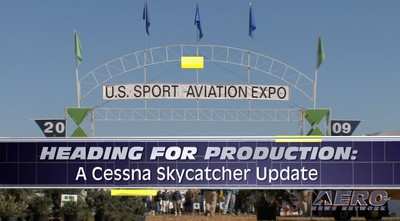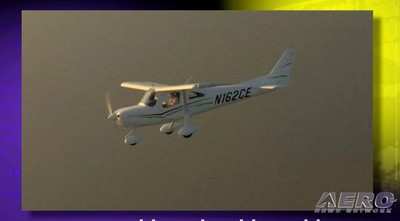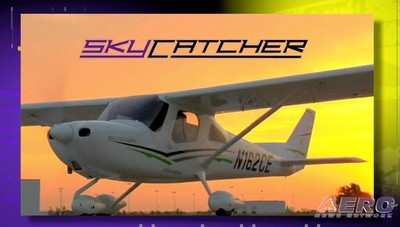Thu, Mar 05, 2009
It won't be long now... before brand new Cessna LSAs start
taking to the sky to help a new generation of aviators take wing.
At the 2009 US Sport Aviation Expo, ANN's Jim Campbell caught up
with the Cessna folks to get an update on the SkyCatcher
program.

At this time, all engineering work and testing of the 162
SkyCatcher is being completed according to American Society for
Testing and Materials (ASTM) standards. Remaining flight tests are
focused on gathering data and making minor refinements to ensure
the aircraft complies with ASTM requirements and fulfills its
intended role in the training and sport flying market. An extensive
Ground Vibration Test, though not an ASTM requirement, was
conducted to meet Cessna’s lofty standards for airframe
integrity. Additional testing beyond the ASTM requirements will
include a full airframe fatigue test on a production aircraft.
Cessna plans to begin deliveries in the US later this year.

The $111,500 Model 162 has two-seat capacity including the
pilot. Suitable allowance for luggage is provided aft of the seats.
A left hand and right hand door allow access for the pilot and
passenger.
An all-new Garmin G300 avionics package was specifically
designed for the SkyCatcher. A single Garmin G300 display will
provide primary flight, engine and moving map information in a
split screen format. Other standard equipment will include a Garmin
SL40 Com radio, Garmin GTX327 Mode C transponder, VFR GPS and a
121.5 MHz ELT. Options include a second MFD, audio panel and
autopilot.

The SkyCatcher's use of a novel iteration of dual control sticks
makes for a roomy and functional cockpit.
Teledyne Continental's new O-200D will be doing motivational
duty for all SkyCatchers. The SkyCatcher's Continental O-200D is an
air-cooled, four-cylinder, naturally aspirated, spark ignition,
direct drive engine that produces a maximum of 100 brake horsepower
at 2,800 RPM. The Continental O-200D allows for a cruise at speeds
up to 118 knots, with a range of 470 nautical miles and a service
ceiling of 15,500 feet. The Takeoff Distance is 1250 ft, Landing
Distances are reported to be 1040 ft and the SL ROC is 890 fpm.

More News
“Honored to accept this mission. Time to take over space. Let’s launch.” Source: SecTrans Sean Duffy commenting after President Donald Trump appointed U.S. Secret>[...]
Permanent Echo Radar signals reflected from fixed objects on the earth's surface; e.g., buildings, towers, terrain. Permanent echoes are distinguished from “ground clutter&rd>[...]
Aero Linx: European Hang Gliding and Paragliding Union (EHPU) The general aim of the EHPU is to promote and protect hang gliding and paragliding in Europe. In order to achieve this>[...]
Glider Encountered A Loss Of Lift And There Was Not Sufficient Altitude To Reach The Airport Analysis: The flight instructor reported that while turning final, the glider encounter>[...]
Airplane Climbed To 100 Ft Above Ground Level, At Which Time The Airplane Experienced A Total Loss Of Engine Power On May 24, 2025, at 1300 eastern daylight time, an Aeronca 7AC, N>[...]
 Aero-News: Quote of the Day (07.11.25)
Aero-News: Quote of the Day (07.11.25) ANN's Daily Aero-Term (07.11.25): Permanent Echo
ANN's Daily Aero-Term (07.11.25): Permanent Echo ANN's Daily Aero-Linx (07.11.25)
ANN's Daily Aero-Linx (07.11.25) NTSB Final Report: Schweizer SGS 2-33A
NTSB Final Report: Schweizer SGS 2-33A NTSB Prelim: Aeronca 7AC
NTSB Prelim: Aeronca 7AC






